- Scientific name: Carex alopecoideaTuck.
- Species of Greatest Conservation Need (MA State Wildlife Action Plan)
- Threatened (MA Endangered Species Act)
Description
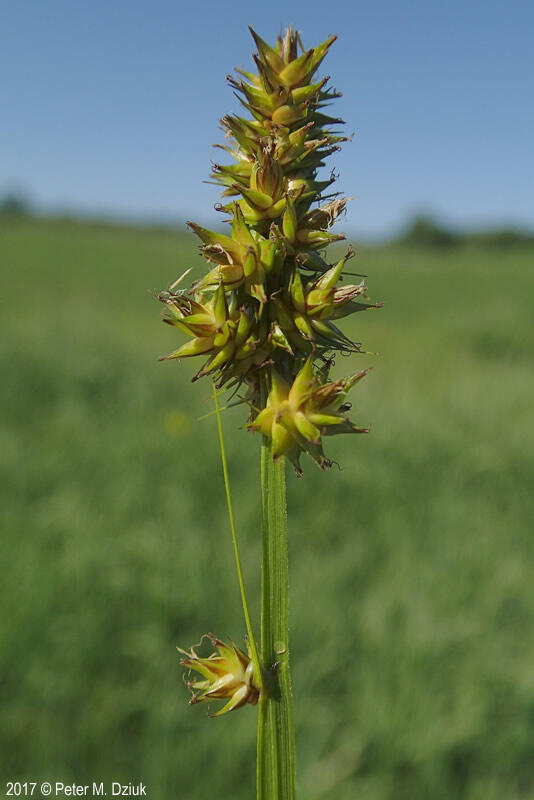
Dense inflorescence of many spikes, image by Peter Dziuk, minnesotawildflowers.info
Foxtail sedge (Carex alopecoidea), a member of the sedge family (Cyperaceae), is a perennial, herbaceous, grass-like plant found in calcareous wet meadows of river floodplains, or occasionally within forested floodplains with partially open canopies. It is a densely tufted, stout but soft, plant that is 40-80 cm (1-2.5 ft) tall with fruiting stems that are usually shorter than the dark green thin, soft leaves. The leaves grow up to 60 cm (2 ft) long and 7 mm (0.28 in) wide, and the upper leaf sheaths are colorless, fragile, and red-dotted on the front. The basal leaves may persist as fibrous dark fibers. The leaves are smooth with no hairs.
To positively identify foxtail sedge and other members of the genus Carex, a technical manual should be consulted. Species in this genus have tiny, wind-pollinated flowers that are borne in spikes. Each flower is unisexual, and is closely subtended by small, flat scales that sometimes conceal the flowers. The staminate (i.e., pollen-bearing) flowers are subtended by a single scale. The pistillate (i.e., ovule-bearing) flowers are subtended by two scales, an outer flat scale (pistillate scale) and an inner, sac-like scale, called a “perigynium,” that encloses the flower, and later, the achene (fruit). If the perigynium tapers or contracts to a tip, it is described as a “beak.”
Foxtail sedge belongs to a group of Carex species (section Vulpinae) that usually have congested spikes (several small spikes clustered together), spongy or “corky” tissue inside the perigynium bases, and tapered (vs. abruptly contracted) perigynium beaks. The flowering culms (stems) are typically 4 mm (0.16 in) wide at the base and have a terminal inflorescence at top of the spongy textured 3-sided stem. The upper edges of the stem are scabrous. In foxtail sedge, the inflorescence has 8 to 12 crowded spikes subtended by a bristle-like bract. The congested inflorescence is thick-cylindric to lance-shaped, 2-4 cm (0.75-1.5 in) long; staminate flowers are at the tips of the spikes. Perigynia are flat, rounded at the base, and gradually tapered at the tip into a rough beak. They become wholly or partly brown at maturity, with 2 to 3 veins on the convex outer face, and no veins on the flat inner face. The achenes (tiny, hard fruits) are lenticular (lens-shaped) and fill only part of the perigynia.
Species that could be confused with the foxtail sedge in wet meadows and floodplains of Massachusetts include the fox sedge (Carex vulpinoidea), wrinkle-sheathed sedge (C. stipata), and smooth-sheathed sedge (C. laevivaginata). It may also be confused with thin-leaved sedge (C. cephaloidea). The widespread C. vulpinoidea and C. stipata have “corrugated” or wrinkled leaf sheaths, unlike the smooth sheaths of the foxtail sedge. Carex laevivaginata has smooth sheaths similar to foxtail sedge; however, they are not red-dotted as in the foxtail sedge. Both C. stipata and C. laevivaginata have perigynia that are more than 4 mm (>0.15 in) long, while C. alopecoidea perigynia are only 3-4 mm (0.11-0.15 in) long. Thin-leaved sedge (C. cephaloidea) closely resembles foxtail sedge; however, it is typically found in drier sites such as rich woods and meadows; it also has corrugated leaf sheaths.
Key features to identify foxtail sedge include (quoted from Arsenault et al. 2013):
- “Stems spongy, 3-sided in cross-section
- Leaf sheaths fragile, with reddish or brown dots near margin
- Spikes all similar, sessile, ascending, crowded
- Perigynium body mostly rounded at base, not conspicuously spongy.”
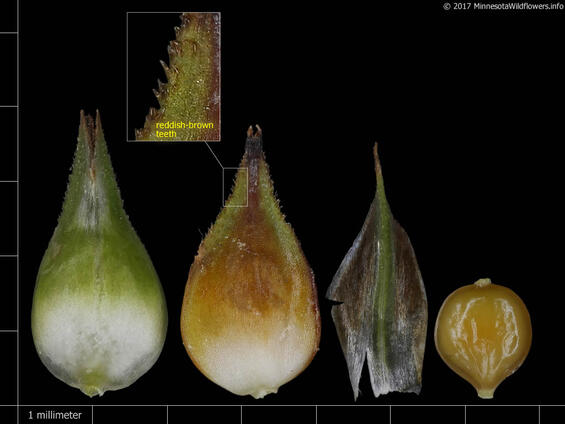
Photo of both sides of perigynia, scale and achene, image by minnesotawildflowers.info.
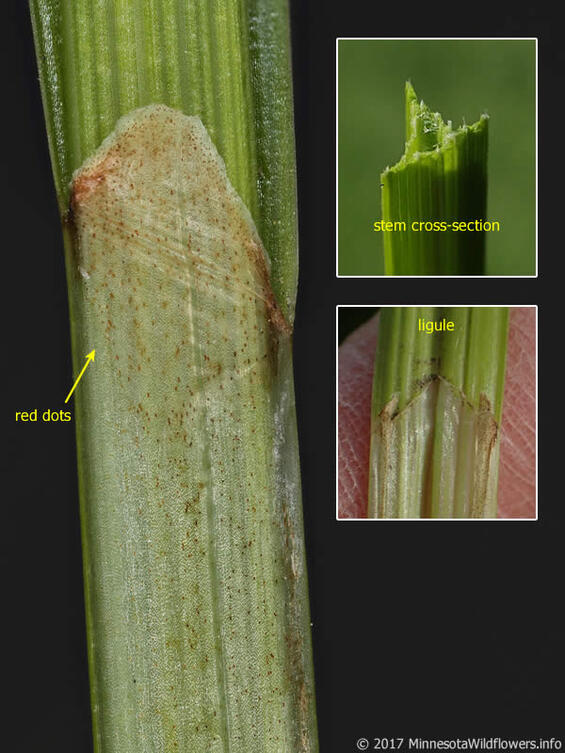
Leaf sheath is red dotted, image by minnesotawildflowers.info.
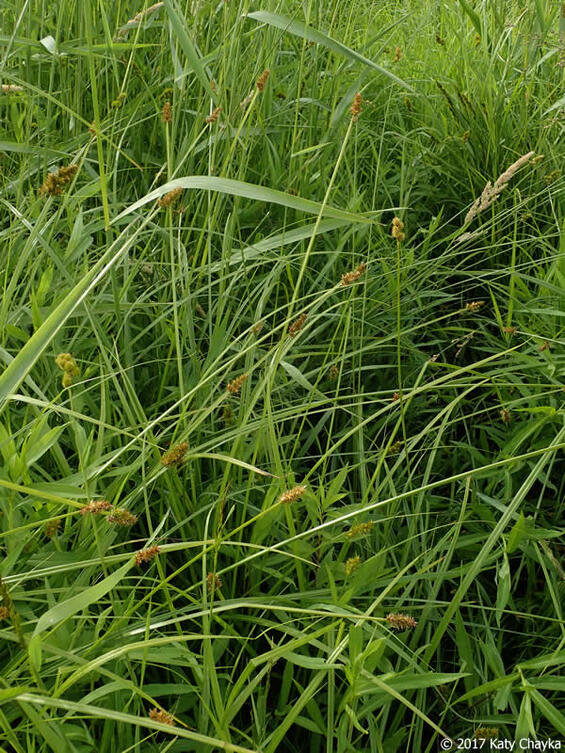
Image by Katy Chayka, minnesotawildflowers.info
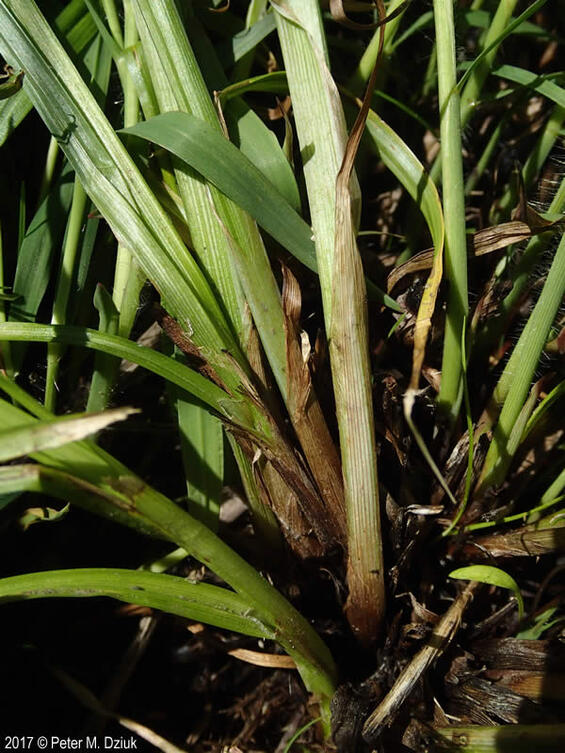
Basal sheaths, image by Peter Dziuk, minnesotawildflowers.info
Life cycle and behavior
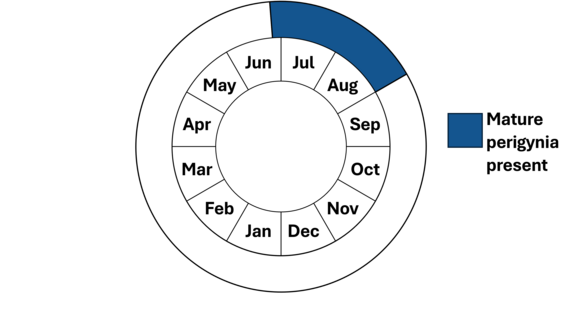
Foxtail sedge is a perennial species that lives for many years. Foxtail sedge reproduces vegetatively by short rhizomes, forming dense tufts. This is a spring blooming sedge, producing flowers between mid-May and mid-June and is wind pollinated. It is not known whether this species can self-pollinate but is thought it likely can. Mature perigynia and achenes are present from late June through mid-August. In this sedge, the mature perigynia are needed for definitive identification. Although it is not known conclusively, it has been proposed that the fruits of foxtail sedge may be dispersed by water during flooding events or by birds or other animals which consume the seeds. It is unknown how long the seeds will remain viable in the seed bank, though many sedges will remain viable for several years.
Population status
Foxtail sedge is listed under the Massachusetts Endangered Species Act as threatened. All listed species are protected from killing, collecting, possessing, or sale and from activities that would destroy habitat and thus directly or indirectly cause mortality or disrupt critical behaviors. There are eight current stations (discovered or relocated since 1999) of foxtail sedge in Massachusetts. They occur in five towns in Berkshire County along the Hoosic and Housatonic Rivers. Of these eight populations, 3 are doing well, with several plants observed.
Distribution and abundance
The documented range of foxtail sedge extends from Nova Scotia and Maine west to Saskatchewan with a disjunct population in Wyoming and south to Indiana, Tennessee and West Virginia. In New England, it is thought to be extirpated in Maine; it is listed as critically imperiled in Connecticut and Vermont and imperiled in Massachusetts. Neither Rhode Island nor New Hampshire have assessed its rank. Most states and provinces where foxtail sedge occurs have listed it as rare or vulnerable. Only New York considers it secure, and Ontario considers it apparently secure. It is also considered extirpated from Tennessee.
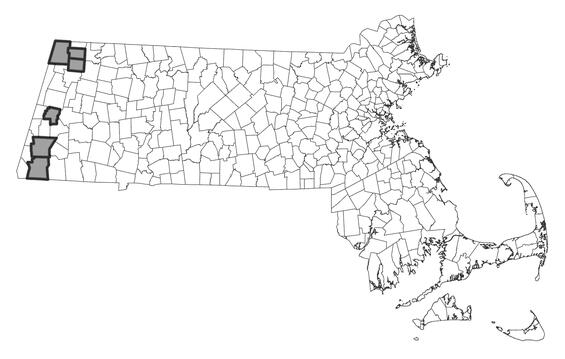
Distribution in Massachusetts
2000-2025
Based on records in the Natural Heritage Database
Habitat
Foxtail sedge grows in floodplain meadows and occasionally floodplain forests, generally in alkaline alluvial soils. In Massachusetts, foxtail sedge is typically found with other sedges, grasses, and herbs in open swales within floodplain meadows and forests. The soils are typically seasonally saturated yearly. Associated species include ostrich fern (Matteuccia struthiopteris), sensitive fern (Onoclea sensibilis), false hellebore (Veratrum viride), false nettle (Boehmeria cylindrica), clearweed (Pilea pumila), wood nettle (Laportea canadensis), bedstraws (Galium spp.), jumpseed (Persicaria virginianum), reed canary grass (Phalaris arundinacea), and various sedges, including hairy-fruited sedge (C. trichocarpa, a state Threatened species), and fox sedge (C. vulpinoidea). Associated floodplain forest trees include silver maple (Acer saccharinum), black willow (Salix nigra), basswood (Tilia americanum), and American elm (Ulmus americana).
Threats
Foxtail sedge faces many threats in Massachusetts. Invasive plant species growing in its habitat can shade out the sedge preventing it from growing. With insufficient disturbance, there is a threat of canopy closure within their habitat. Powerline right-of-ways (ROWs) maintenance or renewal can be either a threat or a help depending on the work activities. Careful surveys done prior to utilities-related work can help to protect the species and update the known populations and their management needs where those occur on utility ROWs.
Other potential threats include deer browse and beavers flooding habitats that support this sedge. In floodplain forests, off road vehicles can cause significant damage to the wetland community. For populations that occur in fields, inappropriate timing of mowing when the seeds are not yet mature can decrease the viability of a population. For calcareous fens in general, altered hydrology and degradation of water entering the fens due to development nearby is a major threat to these natural communities. Finally, climate change has also been proposed as a potential threat to foxtail sedge. Calcareous fens require a stable hydrological regime, so are vulnerable to changes due to climate change, including increased and more frequent precipitation, increased and longer droughts, and higher temperatures, all of which are likely to benefit invasive plant species (Dodd 2023; Staudinger et al. 2024).
Conservation
Survey and monitoring
Survey is needed for several of the older populations of foxtail sedge which have not been observed within the past 10 to 15 years or more. The best time to survey this species is when it is in seed from July through August. Because this species will spread only a short distance via its rhizomes, clumps of this sedge rather than fruiting stems should be counted as genets. Floodplain meadows and forests can be large areas, so it may be difficult to get a full assessment of the population. Several surveys over time can be helpful for that assessment.
Management
A primary management need in floodplain meadows and forests is the control of invasive plant species. Many of these habitats have become a dense tangle of mostly invasive species, shading out native plant species and making the habitats difficult for native animals to navigate as well. All active management of rare plant populations (including invasive species removal) is subject to review under the Massachusetts Endangered Species Act and should be planned in close consultation with the MassWildlife’s Natural Heritage & Endangered Species Program.
Loss of natural floodplain habitat appears to be a major cause of rarity in Massachusetts. To maintain the existing native populations and to prevent foxtail sedge’s extirpation from the Commonwealth, it is critical that its habitat remain intact. Known populations of foxtail sedge in Massachusetts occur along rivers and streams that experience periodic flooding. The disturbance seasonal flooding causes may be necessary to perpetuate foxtail sedge populations by limiting shrub growth and maintaining an open community structure. Any alteration of stream or river hydrology should be avoided in areas where foxtail sedge occurs.
It is also important to protect the habitats of foxtail sedge from inappropriate activities, including use by off-road vehicles and discharge of stormwater from developments.
Research needs
As for many rare species, the exact needs of foxtail sedge are not known. Research is needed into the length of time foxtail sedge seed remains viable and whether the species uses (or requires) mycorrhizae to grow, and which fungi are important. It is known that some sedges have a relationship with mycorrhizal fungus.
References
Arsenault, Matt, Glen H. Mittelhauser, Don Cameron, Alison C. Dibble, Arthur Haines, Sally C. Rooney, and Jill E. Weber. 2013. Sedges of Maine, A Field Guild to Cyperaceae. University of Maine Press, Orono, Maine.
Dodds, Jill S. 2022. Carex alopecoidea Rare Plant Profile. New Jersey Department of Environmental Protection, State Parks, Forests & Historic Sites, State Forest Fire Service & Forestry, Office of Natural Lands Management, New Jersey Natural Heritage Program, Trenton, NJ. 16 pp. https://www.nj.gov/dep/parksandforests/natural/heritage/docs/carex-alopecoidea-foxtail-sedge.pdf
Haines, Arthur. Flora Novae Angliae. New England Wild Flower Society, Yale University Press, New Haven, CT. 2011.
MinnesotaWildflowers.info website. Carex alopecoidea (Foxtail sedge). https://www.minnesotawildflowers.info/grass-sedge-rush/foxtail-sedge. Accessed 3/4/2025.
Native Plant Trust. 2014. NORM Phenology Information.
NatureServe. 2025. NatureServe Network Biodiversity Location Data accessed through NatureServe Explorer [web application]. NatureServe, Arlington, Virginia. Available https://explorer.natureserve.org/. Accessed: 3/4/2025.
POWO (2025). "Plants of the World Online. Facilitated by the Royal Botanic Gardens, Kew. Published on the Internet; https://powo.science.kew.org/ Retrieved 3/4/2025."
Seymour, Frank C. 1969. The Flora of New England, First edition. Charles E. Tuttle Company, Inc. Tokyo, Japan.
Staudinger, M.D., A.V. Karmalkar, K. Terwilliger, K. Burgio, A. Lubeck, H. Higgins, T. Rice, T.L. Morelli, A. D'Amato. 2024. A regional synthesis of climate data to inform the 2025 State Wildlife Action Plans in the Northeast U.S. DOI Northeast Climate Adaptation Science Center Cooperator Report. 406 p. https://doi.org/10.21429/t352-9q86
Contact
| Date published: | March 25, 2025 |
|---|